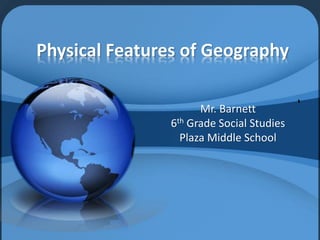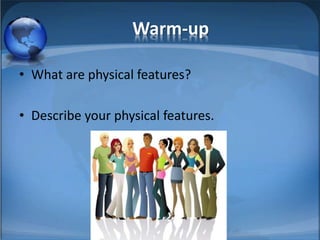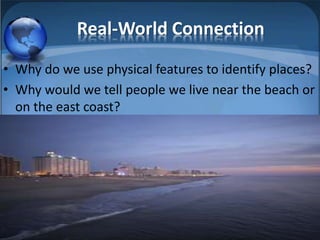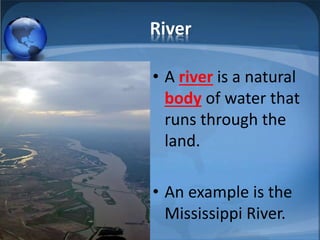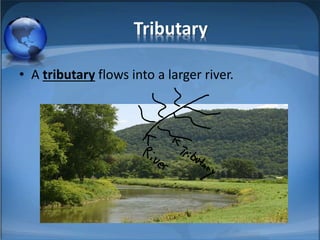Physical features
- 1. Physical Features of Geography Mr. Barnett 6th Grade Social Studies Plaza Middle School
- 2. Warm-up âĒ What are physical features? âĒ Describe your physical features.
- 3. Real-World Connection âĒ Why do we use physical features to identify places? âĒ Why would we tell people we live near the beach or on the east coast?
- 4. Real World Connection âĒ Why would identifying physical features be important to historians? âĒ (Studying early people in North American and where they settled) âĒ We must adapt to our physical environment to survive.
- 5. Mountains âĒ Mountains are large landmasses higher than a hill. âĒ A mountain is the highest kind of land. âĒ A mountain has a peak. âĒ A group of mountains together is called a mountain range.
- 6. Hill âĒ A hill is a rounded elevation of land âĒ A hill is land that rises above the land around it. âĒ A hill has a rounded top.
- 7. Plain âĒ A plain is an area of land usually at low elevation.
- 8. Plateau âĒ A plateau is a large area of high land.
- 9. River âĒ A river is a natural body of water that runs through the land. âĒ An example is the Mississippi River.
- 10. Tributary âĒ A tributary flows into a larger river.
- 11. Gulf âĒ A gulf is a part of an ocean partly or mostly surrounded by land. âĒ The Gulf of Mexico is the 10th largest body of water in the world
- 12. Bay âĒ A bay is a body of water smaller than a gulf.
- 13. Island âĒ An island is a land form, smaller than a continent, surrounded by water.
- 14. Peninsula âĒ A peninsula is a long, narrow portion of land extending out into the ocean. âĒ ***It is boarded by water on 3 (three) sides.***
- 15. Lake âĒ A lake is an inland body of standing water of considerable size. Examples are the 5 (five) Great Lakes!
- 16. So Why Are Geologic Features Important? âĒ They are important because they impact: â patterns of trade â the locations of cities and towns â the westward movement â agricultural and fishing industries.
- 17. Gallery Walk Directions 1. You will work in your group. 2. You will use your graphic organizer. 3. Define the term. (use notes) 4. You will identify which picture goes with which geography term. 5. Answer the question
